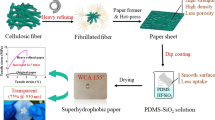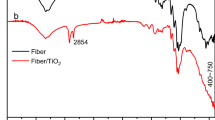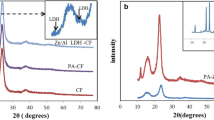Abstract
Interest in superhydrophobic paper is growing, and efforts have been made to prepare superhydrophobic paper with an improved physical strength property. This study reported a facile method for fabricating a superhydrophobic paper with enhanced physical strength through layer-by-layer self-assembly of poly(allylamine hydrochloride) (PAH) and lignosulfonates-amine (LSA) on cellulose fiber surfaces, followed by a heat treatment at 160 °C for 30 min. The formation of PAH/LSA multilayers on cellulose fiber surfaces was confirmed by X-ray photoelectron spectroscopy (XPS), zeta potential measurement and atomic force microscopy (AFM). The XPS results showed that the contents of the two characteristic elements (i.e., Cl and S) increased with increasing bilayer numbers. The zeta potential of modified fibers was regularly inversed after each layer deposition. The AFM phase image revealed that the surface root-mean-square roughness of modified cellulose increased along with the increasing bilayer number. Moreover, the wetting properties and physical strength of handsheets prepared from modified cellulose fibers with and without heat treatment were tested, respectively. The result showed that the water contact angle was higher when LSA was in the outermost layer than when PAH was in the outermost layer, and the heat treatment improved the hydrophobicity for all the handsheets. The non-heat-treated handsheet prepared from (PAH/LSA)5 multilayer-modified fibers gave a water contact angle of 120.3º, and then after heat treatment, the contact angle reached up to 151.7º, indicating that high temperature treatment induced the most hydrophobic long chain groups in LSA macromolecules orientated to the multilayer-air interface. The tensile strength properties of both non-heat-treated and heat-treated handsheets made from PAH/LSA-modified fibers were significantly enhanced. When a (PAH/LSA)5 multilayer was deposited on the cellulose fiber surface, the tensile strength increased by 33.9 % for non-heat-treated handsheets and by 57.8 % for heat-treated handsheets compared to that of handsheets made from original fibers, respectively.












Similar content being viewed by others
References
Agarwal M, Xiang Q, Shim BS et al (2009) Conductive paper from lignocelluloses wood microfibers coated with a nanocomposite of carbon nanotubes and conductive polymers. Nanotechnology 20:215602–215610
Balu B, Breedveld V, Hess DW (2008) Fabrication of “roll-off” and “sticky” superhydrophobic cellulose surfaces via plasma processing. Langmuir 24(9):4785–4790
Costa SM, Mazzola PG, Silva JCAR et al (2013) Use of sugar cane straw as a source of cellulose for textile fiber production. Ind Crops Prod 42:189–194
Crick CR, Bear JC, Kafizas A et al (2012) Superhydrophobic photocatalytic surfaces through direct incorporation of titania nanoparticles into a polymer matrix by aerosol assisted chemical vapor deposition. Adv Mater 24(26):3505–3508
Decher G (1997) Fuzzy nanoassembilies: toward layered polymeric multicomposites. Science 277:1232–1237
Decher G, Hong JD (1991) Buildup of ultrathin multilayer films by a self-assembly process. 1. Consecutive adsorption of anionic and cationic bipolar amphiphiles on charged surface. Makromol Chem Macromol Symp 46:321–327
Dong AX, Fan XR, Wang Q et al (2015) Hydrophobic surface functionalization of lignocellulosic jute fabrics by enzymatic grafting of octadecylamine. Int J Biol Macromol 79:353–362
Feng L, Song YL, Zhai J et al (2003) Creation of a superhydrophobic surface from an amphiphilic polymer. Angew Chem Int Ed 115(7):824–826
Fu JH, Ji J, Yuan WY et al (2005) Construction of atni-adhesive and antibacterial multilayer films via layer-by-layer assembly of heparin and chitosan. Biomaterials 26(33):6684–6692
Gao ZX, Zhai XL, Liu F et al (2015) Fabrication of TiO2/EP super-hydrophobic thin film on filter paper surface. Carbohydr Polym 128:24–31
Garcia-Ubasart J, Esteban A, Vila C et al (2011) Enzymatic treatments of pulp using laccase and hydrophobic compounds. Bioresour Technol 102(3):2799–2803
Garcia-Ubasart J, Colom JF, Carlos V et al (2012) A new procedure for the hydrophobization of cellulose fibre using laccase and a hydrophobic phenolic compound. Bioresour Technol 112:341–344
Gimåker M, Wågberg L (2009) Adsorption of polyallylamine to lignocellulosic fibres: effect of adsorption conditions on localisation of adsorbed polyelectrolyte and mechanical properties of resulting paper sheets. Cellulose 16(1):87–101
Gustafsson E, Larsson PA, Wågberg L (2012) Treatment of cellulose fibres with polyelectrolytes and wax colloids to create tailored highly hydrophobic fibrous networks. Colloids Surf A 414:415–421
Huang LH, Chen KF, Lin CX et al (2011) Fabrication and characterization of superhydrophobic high opacity paper with titanium dioxide nanoparticles. J Mater Sci 46(8):2600–2605
Hubbe MA (2014) Puzzling aspects of the hydrophobic sizing of paper and its inter-fiber bonding ability. BioResources 9(4):5782–5783
Khan A, Huq T, Khan RA et al (2014) Nanocellulose-based composites and bioactive agents for food packaging. Crit Rev Food Sci Nutr 54(2):163–174
Köklükaya O, Carosio F, Grunlan JC et al (2015) Flame-retardant paper from wood fibers functionalized via layer-by-layer assembly. ACS Appl Mater Interfaces 7(42):23750–23759
Li ZX, Xing YJ, Dai JJ (2008) Superhydrophobic surfaces prepared from water glass and non-fluorinated alkylsilane on cotton substrates. Appl Surf Sci 254(7):2131–2135
Li H, Fu SY, Peng LC et al (2012) Surface modification of cellulose fibers with layer-by-layer self-assembly of lignosulfonate and polyelectrolyte: effects on fibers wetting properties and paper strength. Cellulose 19(2):533–546
Liu H, Fu SY, Li H et al (2009) Layer-by-layer assembly of lignosulfonates for hydrophilic surface modification. Ind Crops Prod 30(2):287–291
Lu ZH, Eadula S, Zheng ZG et al (2007) Layer-by-layer nanoparticle coatings on lignocelluloses wood microfibers. Colloids Surf A 292(1):56–62
Marais A, Wågberg L (2012) The use of polymeric amines to enhance the mechanical properties of lignocellulosic fibrous networks. Cellulose 19(4):1437–1447
Marais A, Utsel S, Gustafsson E et al (2014) Towards a super-strainable paper using the Layer-by-Layer technique. Carbohydr Polym 100:218–224
Maximova N, Österberg M, Koljonen K et al (2001) Lignin adsorption on cellulose fibre surfaces: effect onsurface chemistry, surface morphology and paper strength. Cellulose 8:113–125
Mourad AL, Silva HLG, Nogueira JCB (2012) Carton for beverage-Adecade of process efficiency improvements enhancing its environmental profile. Int J Life Cycle Assess 17(2):176–183
Ogihara H, Xie J, Okagaki J et al (2012) Simple method for preparing superhydrophobic paper: spray-deposited hydrophobic silica nanoparticle coatings exhibit high water-repellency and transparency. Langmuir 28(10):4605–4608
Pan CY, Shen L, Shang SM et al (2012) Preparation of superhydrophobic and UV blocking cotton fabric via sol–gel method and self-assembly. Appl Surf Sci 259:110–117
Ramamoorthy SK, Skrifvars M, Persson A (2015) A review of natural fibers used in biocomposites: plant, animal and regenerated cellulose fibers. Polym Rev 55(1):107–162
Rathi MS, Biermann CJ (2000) Application of polyallylamine as a dry strength agent for paper. Tappi J 83(12):62
Roy D, Semsarilar M, Guthrie JT et al (2009) Cellulose modification by polymer grafting: a review. Chem Soc Rev 38(7):2046–2064
Songok J, Tuominen M, Teisala H et al (2014) Paper-based microfluidics: fabrication technique and dynamics of capillary-driven surface flow. ACS Appl Mater Interfaces 6(22):20060–20066
Sousa MP, Mano JF (2013) Superhydrophobic paper in the development of disposable labware and lab-on-paper devices. ACS Appl Mater Interfaces 5(9):3731–3737
Sun B, Hou QX, Liu ZH et al (2014) Stability and efficiency improvement of ASA in internal sizing of cellulosic paper by using cationically modified cellulose nanocrystals. Cellulose 21(4):2879–2887
Tian LM, Morrissey JJ, Kattumenu R et al (2012) Bioplasmonic paper as a platform for detection of kidney cancer biomarkers. Anal Chem 84(22):9928–9934
Wang YG, Wang X, Heim LO et al (2015) Superhydrophobic surfaces from surface-hydrophobized cellulose fibers with stearoyl groups. Cellulose 22(1):289–299
Werner O, Quan C, Turner C et al (2010) Properties of superhydrophobic paper treated with rapid expansion of supercritical CO2 containing a crystallizing wax. Cellulose 17(1):187–198
Wu TF, Farnood R (2014) Cellulose fibre networks reinforced with carboxymethyl cellulose/chitosan complex layer-by-layer. Carbohydr Polym 114:500–505
Wu TF, Farnood R (2015) A preparation method of cellulose fiber networks reinforced by glutaraldehyde-treated chitosan. Cellulose 22(3):1955–1961
Xing Q, Eadula SR, Lvov YM (2007) Cellulose fiber-enzyme composites fabricated through layer-by-layer nanoassembly. Biomacromolecules 8(6):1987–1991
Yang H, Deng YL (2008) Preparation and physical properties of superhydrophobic papers. J Colloid Interface Sci 325(2):588–593
Yue XP, Chen FG, Zhou XS (2011) Improved interfacial bonding of PVC/wood-flour composites by lignin amine modification. BioResources 6(2):2022–2034
Zhai L, Cebeci FC, Cohen RE et al (2004) Stable superhydrophobic coating from polyelectrolyte multilayers. Nano Lett 4(7):1349–1353
Zhang X, Shi F, Yu X et al (2004) Polyelectrolyte multiayer as matrix for electrochemical deposition of gold clusters: toward super-hydrophobic surface. J Am Chem Soc 126:3064–3065
Zhang M, Wang SL, Wang CY et al (2012) A facile method to fabricate superhydrophobic cotton fabrics. Appl Surf Sci 261:561–566
Zhang LB, Wu JB, Hedhili MN et al (2015) Injet printing for direct micropatterning of a superhydrophobic surface: toward biomimetic fog harvesting surfaces. J Mater Chem A 3:2844–2852
Zhao Y, Xu ZG, Wang XG et al (2013) Superhydrophobic and UV-blocking cotton fabrics prepared by layer-by-layer assembly of organic UV absorber intercalated layered double hydroxides. Appl Surf Sci 286:364–370
Acknowledgments
This work is financially supported by the National Natural Science Foundation of China (no. 20150028), the Applied Basic Research Program of Yunnan Province (no. 2014FD008), the Talent Training Program of Yunnan Province (no. KKSY201305002) and State Key Laboratory Open Foundation of Pulp and Paper Engineering of China (no. 201323).
Author information
Authors and Affiliations
Corresponding author
Rights and permissions
About this article
Cite this article
Peng, L., Meng, Y. & Li, H. Facile fabrication of superhydrophobic paper with improved physical strength by a novel layer-by-layer assembly of polyelectrolytes and lignosulfonates-amine. Cellulose 23, 2073–2085 (2016). https://doi.org/10.1007/s10570-016-0910-5
Received:
Accepted:
Published:
Issue Date:
DOI: https://doi.org/10.1007/s10570-016-0910-5




